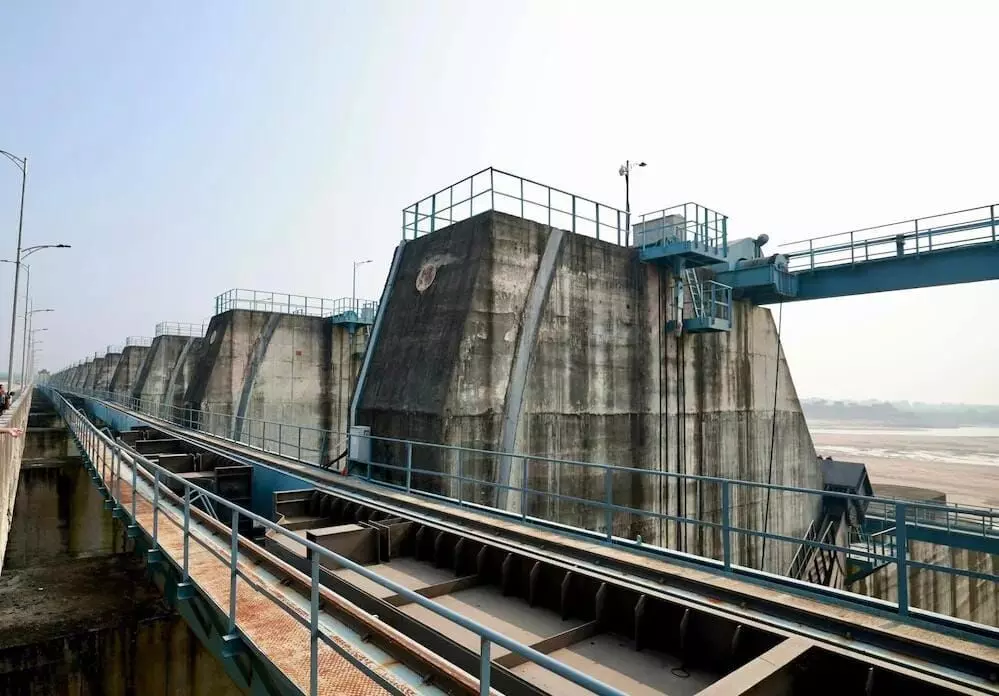Kaleshwaram project: NDSA report on Medigadda Barrage faults planning, design, quality, maintenance
On October 21, pillar number 15 to 20 of the Medigadda (Lakshmi Barrage) barrage sunk in
By Sri Lakshmi Muttevi
Representational Image
Telangana: The sinking of piers in Medigadda barrage, as part of the Kaleshwaram project, is a result of a combination of issues related to planning, design, quality control, and operation and maintenance. The primary cause of the failure is the settlement of the barrage raft, stated the report by the National Dam Safety Authority which recently inspected the prestigious irrigation project in Telangana.
On October 21, pillar number 15 to 20 of the Medigadda (Lakshmi Barrage) barrage sunk in.
Days later, another barrage leak was reported in the construction of the Kaleshwaram project at the Annaram Saraswati Barrage in Mahadevpur mandal of Jayashankar Bhupalpally district. It was reported that the water leakage was noticed at two gates, number 28 and 38. This is the second leakage reported in the Kaleshwaram project.
Following this, a six-member committee, led by the Member (Disaster & Resilience) of the National Dam Safety Authority investigated the sinking of the piers at Medigadda Barrage from October 23 to 25. A report submitted by the team stated that the barrage, under its present condition, is rendered useless until fully rehabilitated.
The committee conducted discussions with the engineering-in-chief (General) of the I&CAD Department in Hyderabad, inspected the Medigadda Barrage, and held final discussions with various stakeholders, including the I&CAD Department, L&T Infra Ltd., and SDSO, on the October 25 in Hyderabad.
Based on the site inspection, discussions with stakeholders, and a review of documents provided by the I&CAD Department, the committee has submitted its report to the chairman of the National Dam Safety Authority (NDSA).
What are the primary findings?
1. The sinking of the piers at the Medigadda Barrage resulted from a combination of issues related to planning, design, quality control, and operation and maintenance (O&M).
2. The primary cause of the failure is the settlement of the barrage raft. This settlement has also affected the monolithic piers, causing them to sink, shift, and crack.
3. Possible reasons for this settlement include issues like piping (transportation of foundation material), insufficient bearing capacity of the foundation material (sand), and the failure of upstream secant piles due to the load imposed by the barrage.
4. Damaged block may have to be structurally restored to make it functional.
5. The likelihood of the failure of other blocks resulting in a similar mode exists.
6. The distress condition developed in one block of the Medigadda Barrage is adversely affecting the functionality of the barrage. The barrage under the present condition is rendered useless until fully rehabilitated.
While the committee has requested a list of 20 data inputs for examination, only 11 of these items have been provided. The I&CAD Department has not provided several crucial inputs, including instrumentation data, pre-monsoon and post-monsoon inspection reports, completion reports, quality control reports, and information regarding the condition of gates.
As per the report, the damaged block may have to be structurally restored to make it functional. Filling the reservoir in the present condition would worsen the barrage’s health and should not be resorted.
“The two barrages constructed upstream of Medigadda under the Kaleshwaram Project, viz; Annaram and Sundilla barrages, have similar designs and construction methodologies, making them prone to similar failure modes. Signs of boiling already exist downstream of Annaram Barrage, a precursor to failure. These barrages also should be examined urgently for signs of piping/distress,” the report said.